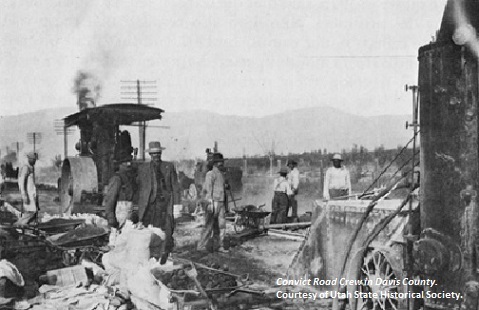Dublin Core
Title
Description
Learn about Utah’s convict labor system and how prisoners actually formed the backbone of some of our early public works projects – especially road construction.
The term "convict labor" usually conjures up images of men wearing black and white stripes, sledgehammers in hand, working on a chain-gang. The use of convict labor has long been a practice of American penal institutions. In Utah, prison inmates have worked to fight forest fires, pick up litter along public roads, and actually, even build those roads.
Prior to Utah statehood, prisoners were contracted out for both public and private jobs, despite federal laws that made selling convict labor for private purposes illegal. When the state constitution was drafted in 1895, the issue was clarified to explicitly prohibit work done by prisoners on private interests, but allowing it for public projects. In 1909, the Utah Legislature passed a law allowing prisoners with terms of less than ten years to work on public road construction. Soon after, the Legislature lifted the ten-year limit and made it possible for any well-behaved prisoner to reduce his sentence by ten days for every thirty days he worked.
These laws coincided with a major road-building program in Utah, and Governor William Spry saw the unpaid work of prisoners as essential in “[giving] Utah one of the greatest road systems in the country.” The first project to benefit from convict labor was a road in Box Elder County. Fifty-two convicts were moved from the state penitentiary into a makeshift camp near Willard, where they slept in tents surrounded by barbed wire and guards. The prisoners worked hard, and racked up more than 6,500 man-days. With wages at $2.25 a day for regular laborers, the State saved more than $14,000 by using convicts. Based on these savings, prisoners were shipped to other parts of the state to build more roads.
Not all Utahns agreed with this practice. In 1911, more than 500 people rallied in Salt Lake City, arguing that using convicts on road crews took good jobs away from the unemployed. It was this kind of criticism that contributed – at least in part – to the demise of this labor practice by the 1920s.
Creator
Source
Image: Convict road crew at work in Davis County was racially integrated. Utah State Road Commission photograph. Courtesy of Utah State Historical Society.
______________
See Allan Kent Powell, “Convict Labor Helped to Build Utah’s Roads,”History Blazer, January 1995, http://www.historytogo.utah.gov; Virgil Caleb Pierce, “Utah’s First Convict Labor Camp,”Utah Historical Quarterly 42 (Summer 1974): 245-257; “Convict-Built Roads Success,” Salt Lake Tribune, May 9, 1911.

